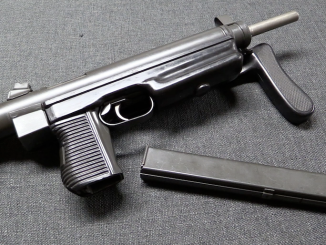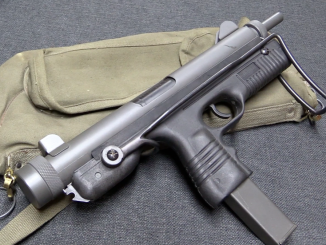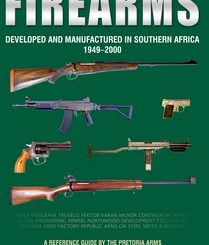The iconic weapon of the Rhodesian Bush War is the FN-FAL, painted in a distinctive “baby poop” yellow and green pattern. Because Rhodesia was under international embargo, its options for obtaining weapons were limited. Some domestic production was undertaken, but one large source was neighboring South Africa. Both South African production FALs and also Belgian-made South African contract FALs were provided. This rifle is one of the latter, with the South African crest and proof marks defaced for some theoretical deniability should it be scrutinized.
Larry Vickers will talk us through this FAL, pointing out the different elements that are distinctly Rhodesian, as well as the unique Halbeck Device – and detachable muzzle brake.
Thanks to Larry for sharing this rifle with us!




You see a similar “cut out” on FALs used by the Sandinista army in Nicaragua in the Eighties. They came from Castro’s Cuba, and had originally had the Batista-era Cuban national seal embossed on the magazine housing in that position. Like the South African FALs, there was a (U.S.)quarter-sized hole where the crest had been cut out.
The Sandinistas passed a lot of these “sanitized” FALs on to leftist revolutionary groups in El Salvador and elsewhere in Central and South America. The Sandinistas preferred AKs for their own use, anyway.
cheers
eon
There was no change in the national Escudo de Armas between the Cuban Republic, the Batistato or dictatorship of Fulgencio Batista, or the Fiedelato and the Cuban Revolutionary state. So the Cuban seal is the Cuban seal. The United States curtailed arms shipments to the Cuban armed forces in March 1958 due to the unseemly conduct of same. Weapons were duly ordered from Belgium, the UK, and Israel. Most of the weapons came too late to play much role in the final collapse of the Batista regime. The revolutionary regime continued to order weapons from Belgium, witness the explosion of La Coubre in Havana harbor in 1960.
An interesting fact is that when Britain readied Hawker Seafury aircraft for shipment, Fidel Castro’s government asked that the order be cancelled and instead some upgraded Hawker Hunter jets should be sent in their stead. The British duly contacted U.S. officials about whether or not they should do so. The Great White Case Officer, Allen Dulles literally told the Brits that under no circumstances should jets be provided to the nascent Cuban DAAFAR. The UK officials rejoinder was that absent UK jet sales, Castro might turn to the USSR and ask for Mig jets. Dulles explained that that would be just fine, insofar as the acquisition of Czech arms by the doomed Jacobo Arbenz government in Guatemala was used to censure him and offered a rationale for the PBSUCCESS operation of the CIA to overthrow him.
Both the Salvadoran FMLN and Nicaraguan FSLN used Cuban sanitized FALs among other weapons, but the years would be the 1970s in Nicaragua prior to Somoza’s overthrow, and the early 1980s in the case of El Salvador. It is thought that the first M16s in El Salvador may have been ex-ARVN/ ex-US surplus provided by Vietnam to Cuba, and thence shipped through various clandestine channels. In the early 1980s the Salvadorans primarily used the G3 until U.S. aid and military largesse changed that quite rapidly.
Somoza also faced a U.S. arms cut-off, and turned to Israel to supply weapons. Photos from 1978 and 1978 show his troops wearing Israeli helmets and carrying Galils and old M1 Garands.
Only after the FSLN triumphed did Kalashnikovs become the official service weapons. In the 1970s it was pretty much “anything that could shoot” with a preponderance of M1 Garands, Venezuelan FALs–some Cuban as well–M16s, etc. The Cuban MININT actually shipped over Mosin-Nagant M44 carbines and old Czech M52 she self-loading rifles to equip pro-FSLN party militias. There are also the famous pictures of the FSLN marching wearing the distinctive DDR Nationale Volksarmee steel helmets.
Dammit, I saw that hole and thought “ha, no-one else but I will no this….” good eye sir.
Ian, I really appreciate your having Larry Vickers on your channel. He is the sort of no nomsense guy that I really admire. I had a chance to speak with him for a brief moment at the NRA Convention in Atlanta last summer and it made my day. Thanks again.
This website does not exist..
Something must have gone wrong..
Thank you,
Eric.
You’re right the video is down
I had been wondering why the takedown lever was redesigned and moved – Mr Vickers’ explanation makes sense.
As for the carrying handle removal, I thought it was done to force the soldiers to always hold their rifle ready for use. I fired an FAL left-handed and never ate brass (always wear shooting glasses).
Interesting video.
The carry handles were order to be removed after a trooper lost an eye from an ejected case in late ’72.
G1 and m962 FALs also made their way into the country courtesy of Portugal. Later R1 FALs produced specifically for Rhodesia were devoid of South African markings, and therefore did not need to have the hole cut in the magazine well or other markings drilled out.
Does anyone have a picture of the Halbek Device in use? I’ve owned two, and they work remarkably well, but I’ve come across neither mention nor photos of the item in the field.
A few minor points. First, the de-SADFed FALs. This wasn’t done for some spooky “deniability” reason. The RSA never denied its support of Rhodesia. If you go back in the newspaper archives there’s a picture of an SADF official, looking grimly generous, handing an FAL to a Rhodesian official, looking grimly grateful. The markings were removed for the simple reason that the rifles weren’t SADF rifles anymore. On the ground, the received wisdom was that the unmarked stuff was an outright gift. Other items, heavy weapons and vehicles for instance, retained their SADF markings. Those were still RSA property, on loan to Rhodesia, and the South Africans expected to get them back at some time in the future. It may be worth noting that in Namibia the FALs and MAGs suppilied to the SWATF (The Ovambo battalions, Lozi battalions, etc.) weren’t SADF marked either.
On the lack of slings, sling swivels, and carrying handles. The received wisdom was that this was a legacy from the SAS in Malaya, that they were all just bush catching encumbrances that slowed down your lightning quick reactions under fire, not to mention your ability to sprint through the vegetation in hot pursuit of the fleeing enemy.
Finally, there wasn’t any secret formula for the paint, or a special pattern for its application. Units used whatever paint was at hand, usually from the motor pool, and applied whatever pattern struck their fancy. It wasn’t the US Army, where it requires years of paperwork, three review boards, and four environmental impact statements, before you can loc-tite a loose screw.
Wafa Wafa, Wasara Wasara.
Is that Willard ‘Chomps’ Fleetwood 1Pl A Coy 1RAR. If it is get back to me shamwari. johnwynnehopkins@gmail.com
Guilty.
‘Chomps’ go on the Rhodesian African Rifles (RAR) facebook site lot of chaps want to say hello shamwari!
If anyone can get a hold of Chomps tell him bob portis is alive and miss him I was his Platoon sergeant in Rangers bob.portis@yahoo.com
cHOMPS. I have been in touch with Tony Husher who is not well living in the Royal British Legion hospital in Nanuiky Kenya. Tony would like to hear from you. We would all like to make contact with you shamwari. My email johnwynnehopkins@gmail.com. Just put my full name into the internet and my facebook etc will come up. Please make contact. The Dwarf John Hop
I’ll bet he hasn’t checked back on this thread.
I’ll swing by his place tomorrow and let him know.
Angus Mcthag if you could do that it would be such a pleasure to make contact with Willard ‘chomps’ Fleetwood again. Many of the guys from 1RAR (Rhodesian African Rifles) are asking after him.Tony Husher, Blacky Swart, Andy Todd, Pat Lawless, Mike Jones, Tony Clark and me John Hopkins.Mick McKenna our CO still well in SA. Unfortunately Bungle, Ray Stocker, Chris Vincent 2RAR, and others have passed on.
Willard-have you been at 701BN after Rhodesia?
Paint was Dupont Centauri paint- mustard yellow, and “baby poop” green. Same paint used to camo vehicles.
Rifles used early in the war still retained slings and carry handles. After ~late 1972, both became increasingly rare, although the BSAP and its units were slower to change. The carry handle folds down flat against the upper receiver and won’t snag on anything. Slings are a different story (I think slings are mostly overrated, but that’s a different discussion.).
I’d love to hear of your experiences, Mr. Fleetwood. Cheers.
Usually when there are fewer bureaucrats to mess with the gun maker, arms procurement for the army becomes more efficient.
As late as the Anglo-Argentine South Atlantic War in ’82 the SAS abjured the use of slings. For all I know, they may still.
Great video, but the comment that rifle grenades never really caught on in the US was slightly misleading. They were issued from WW1 through WW2 and Korea to at least the late 1960s. M31 HEAT rifle grenade was the individual anti armour weapon until replaced by the M72 LAW c. 1963 onwards. The French, other other hand, have now gone the 40mm UGL route with their new rifle, the HK416F.
French are gonna keep RGs also.
Just a quick ‘fuck you’ for the little white supremacist rant at the end – you know how many black people those anti-communist heroes of yours murdered during the colonial period in Rhodesia? More than Mugabe did. Nothing worse than blimpo colonial nostalgists, in love with the idea of lording over the Lesser Races…
You were there Stephan? You walked the ground and fought the fight, putting your own life on the line (Either side.)? If not maybe you should wind your neck in a little and at least consider the possibility that Marxist Leninist propaganda is, and was, just that; propaganda. Just a thought.
Wafa Wafa, Wasara Wasara.
Chomps at least we know the reality of went on in Rhodesia and then Zimbabwe. Contact me John Hop
Stephen McEwan your statement is typical of today’s subliminaly indoctrinated globalists who have no idea of reality and what went on in Rhodesia. Rhodesian forces never intentionally killed innocent civilians, some may have been caught in cross fire while running with Mugabes terrorists. Mugabe’s terrorists killed thousands of innocent Africans in the most brutal and unimaginable ways and after independence killed 30,000 Matabele in 6 months. I bet you support Iran to the hilt as well.
The history of Southern Rhodesia and Zimbabwe is is significant historical interest on all sorts of levels, not least on a military one; the fact that a State with as much recognition as the CSA managed to survive for over a decade under economic sanctions makes it an ideal case study of economic warfare for a start. The ‘bush war’ has all sorts of military lessons for those who care to study it.
However it was, and still is, very difficult to discus the place and history without getting mired in propaganda, and Larry Vickers has not helped here. His claim that Rhodesia was thrown under a bus is so wrong as to be tantamount to a lie.
A lot countries traded with Rhodesia, but not one single one recognised it a an independent nation, not even South Africa! Only South Africa and Portugal gave direct (albiet disguised) military support, but once Portugal withdrew and even Vorster (one of South Africa’s more right wing premiers) decided a white ruled country with 22 blacks to every white had no future, that was it for Rhodesia. Claiming it was simply a battle against communism is simple minded or worse.
Be a man among men. Join the Rhodesian Army
Uhm, why is the video gone? Cant find it on Full30 either.
It’s gone for me too. I hope Ian decides to put it back up. Removing videos kinda goes against the philosophy of preserving firearms knowledge, which is why the channel was founded.
Turns out Larry Vickers has caught a lot of flak recently for some white nationalist type comments posted on his youtube videos about Rhodesia, as said white nationalists have taken to using Rhodesia as an example of how white and black people should live separately. I assume Ian removed the video as to not have issues with racists.
Two reasons for the removal of the carrying handle. One it meant the rifle was either on a sling over the shoulder, or carried in the low ready position. Second, to stop the handle being tucked into the web belt to carry the load while at shoulder arms position. Believe me I still have a bruise on my left forearm from the cocking knob after many hours square-bashing.
Hey Chomps